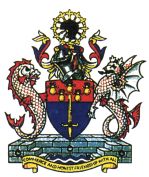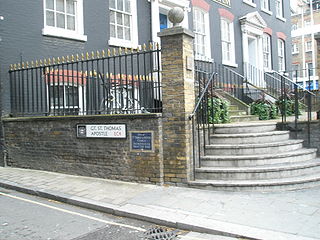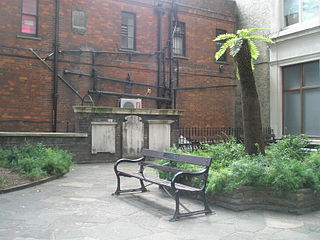
There are 110 livery companies, comprising London's ancient and modern trade associations and guilds, almost all of which are styled the 'Worshipful Company of...' their respective craft, trade or profession. These livery companies play a significant part in the life of the City of London, not least by providing charitable-giving and networking opportunities. Liverymen retain voting rights for the senior civic offices, such as the Lord Mayor, Sheriffs and Corporation, its ancient municipal authority with extensive local government powers.
The Worshipful Company of Scriveners is one of the 110 livery companies of the City of London. The Scriveners Company was originally known as the Mysterie of the Writers of the Court Letter and, since its incorporation, as Master Wardens and Assistants of the Company of Scrivenors of the Cittie of London [sic]. It is one of the few livery companies that from its foundation to the present day has been influential in setting the standards for a living profession, namely that of scrivener notary. The company's first ordinances were granted in 1373. Its Royal Charter was granted by King James I on 28 January 1617.

The Worshipful Company of Clockmakers was established under a Royal Charter granted by King Charles I in 1631. It ranks sixty-first among the livery companies of the City of London, and comes under the jurisdiction of the Privy Council. The company established a library and its Museum in 1813, which is the oldest specific collection of clocks and watches worldwide. This is administered by the company's affiliated charity, the Clockmakers’ Charity, and is presently housed on the second floor of London's Science Museum. The modern aims of the company and its Museum are charitable and educational, in particular to promote and preserve clockmaking and watchmaking, which as of 2019 were added to the HCA Red List of Endangered Crafts.

The Worshipful Company of World Traders is one of the 110 Livery Companies of the City of London.

St Thomas the Apostle was a parish church in Knightrider Street in the City of London. In existence by the late twelfth century, it was destroyed in the Great Fire of London in 1666 and not rebuilt.

John Goodwin (1594–1665) was an English preacher, theologian and prolific author of significant books.

The Clockmakers’ Museum in London, England, is believed to be the oldest collection specifically of clocks and watches in the world. The collection belongs to and is administered by the Clockmakers’ Charity, affiliated to the Worshipful Company of Clockmakers, founded in 1631 by Royal Charter. Since 2015 it has been housed in a gallery provided by the Science Museum in South Kensington, having formerly been located in the Guildhall complex in the City of London since 1874, where it first opened to the public. Admission is free.

Isaac Penington was an English politician who sat in the House of Commons from 1640 to 1653. He was Lord Mayor of London in 1642 and a prominent member of Oliver Cromwell's government.
St Benet Sherehog, additionally dedicated to St Osyth, was a medieval parish church built before the year 1111, on a site now occupied by No 1 Poultry in Cordwainer Ward, in what was then the wool-dealing district of the City of London. A shere hog is a castrated ram after its first shearing.
Theaurau John Tany was an English preacher and religious visionary.
Humphrey Robinson was a prominent London publisher and bookseller of the middle seventeenth century.
James Chaloner (1602–1660) was an English politician on the Parliamentary side in the English Civil War, and commissioner at the trial of King Charles I.

St Peter, Westcheap, also called "St Peter Cheap", "St Peter at the Cross in Cheap", or "Ecclesia S. Petri de Wodestreet", was a parish and parish church of medieval origins in the City of London. The church stood at the south-west corner of Wood Street where it opens onto Cheapside, directly facing the old Cheapside Cross. In its heyday it was a familiar landmark where the City waits used to stand on the roof and play as the great processions went past. It was destroyed in the Great Fire of London in 1666, together with most of its surroundings, and was never rebuilt.

Sir John Cass was an English merchant, Tory Member of Parliament and philanthropist. He was also a key figure in the Royal African Company, which was involved in the Atlantic slave trade.
Richard Farnworth or Farnsworth was an English Quaker writer of tracts.
John Langley was an English merchant and politician who sat in the House of Commons in 1653.
William Henry Overall (1829–1888) was an English librarian and antiquary.
The Grand Lodge of All EnglandMeeting since Time Immemorial in the City of York was a body of Freemasons which existed intermittently during the Eighteenth Century, mainly based in the City of York. It does not appear to have been a regulatory body in the usual manner of a masonic Grand Lodge, and as such is seen as a "Mother Lodge" like Kilwinning in Scotland. It met to create Freemasons, and as such enabled the foundation of new lodges. For much of its career, it was the only lodge in its own jurisdiction, but even with dependent lodges it continued to function mainly as an ordinary lodge of Freemasons. Having existed since at least 1705 as the Ancient Society of Freemasons in the City of York, it was in 1725, possibly in response to the expansion of the new Grand Lodge in London, that they styled themselves the Grand Lodge of All England Meeting at York. Activity ground to a halt some time in the 1730s, but was revived with renewed vigour in 1761.
Charles Gretton was a prominent clock and watchmaker during the golden age of English clockmaking.

Sir William Hewett was a prominent merchant of Tudor London, a founding member and later Master of the Worshipful Company of Clothworkers of London as incorporated in 1528, and the first of that Company to be Lord Mayor of London, which he became in the first year of the reign of Queen Elizabeth I. His career arched across the first four decades of the Company's history, and drew him inexorably, if sometimes reluctantly, into the great public affairs of the age.










